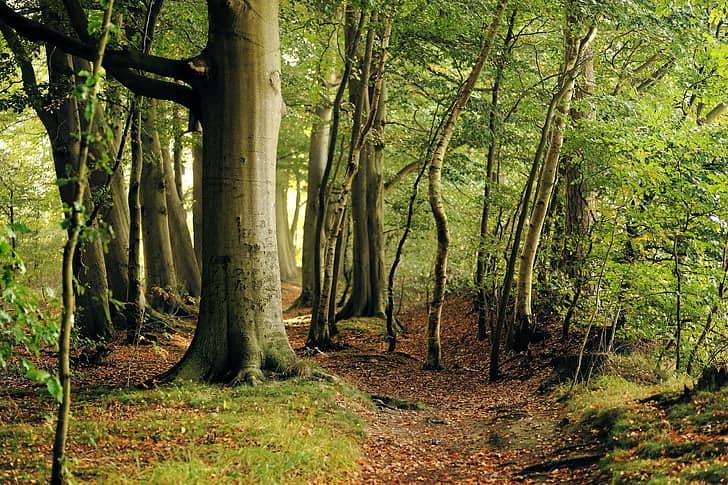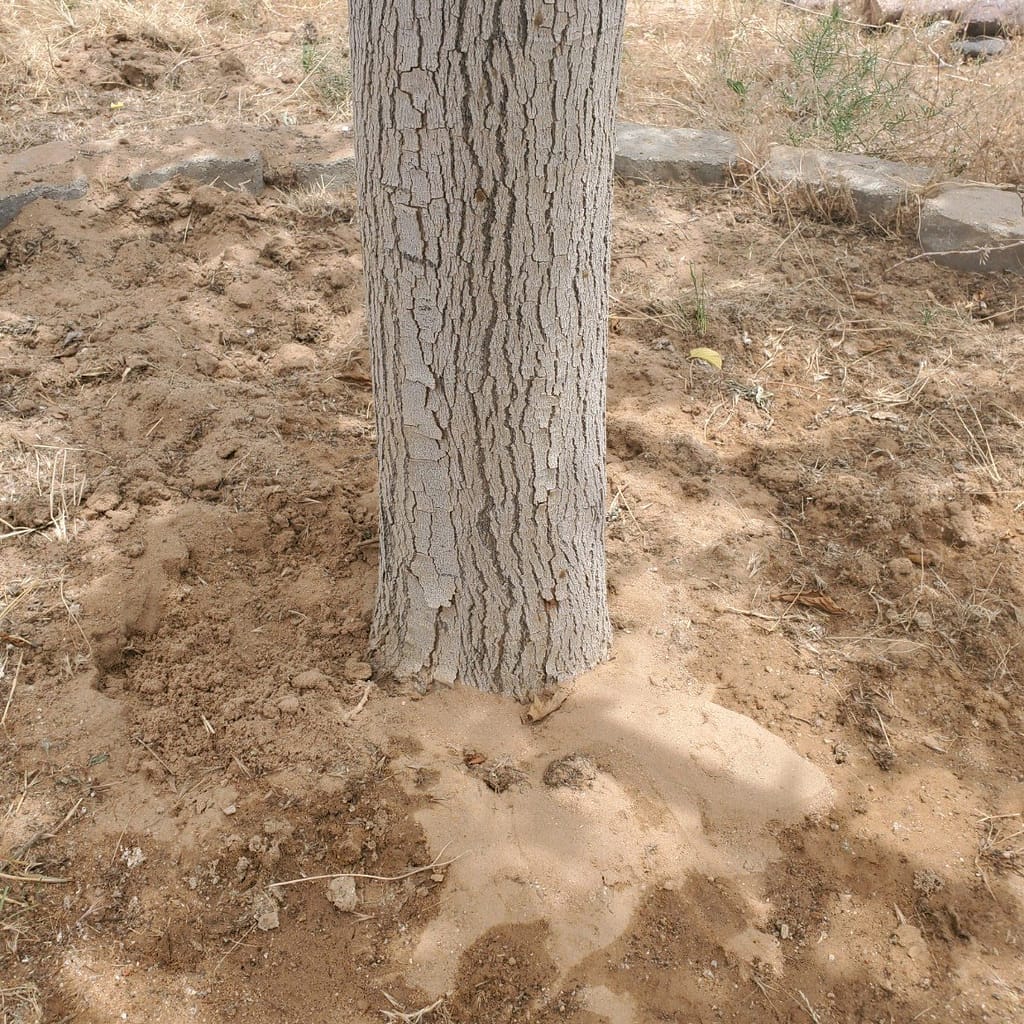
When it comes to the health of our trees the health of the roots is of most importance. Frequently we complain about beetle borers, diseases, and other problems that arise in our trees. These are frequently secondary problems with the real problem being stress on the tree from the lack of health in the root system. Below we’ll discuss the best ways to take care of your tree’s root system.
Root Flare
Having the root flare of your tree uncovered is the easiest thing you can do to improve the health of your tree. This requires uncovering the soil until you see your tree base widen.

This is what a tree looks like when it was planted too deep 
The large tree has a base with a visible root flare. This is ideal
For more information on how to do expose your root flare visit this post: https://www.natesnursery.com/exposing-the-root-flare-of-your-tree/
Compaction of Soil
Soil compaction is the reason that tree roots don’t grow deeply in urban areas. Heavy machinery from construction of concrete, homes, roads, etc. and dragging of yards for weeds with machinery are two of the most common practices that compact urban soil in the high desert. Doing these things while the soil is wet is additionally damaging as soil is more prone to being compacted when wet. Below Larry Morris shared this table about the difference in compaction of humans vs. cars vs. machines:

The top 14 inches that are being compacted are the area where a significant amount of tree roots reside. When the soil is compacted tree roots grow closer to the surface of the soil. This more shallow root system will have a lower tolerance of drought, higher potential to cause damage to hardscapes, and be more easily damaged by surface soil disturbance (dragging, digging, weed killer, etc.).
How To Reverse Compaction
To combat compaction there are a few options, but many of them are not feasible over a large area or do not address deep soil compaction. The options for treatment prior to planting include:
- Using a backhoe (I know, the irony) to break up deeper portions of the soil
- Rototilling (only addresses the top few inches of compaction)
- Subsoiling
- Radial trenching when planting helps trees establish better
Addressing compaction when there is already trees and plants present can be done by:
- Using a high powered air stream to break up surface soil (doesn’t damage roots)
- Vertical mulching which involves drilling holes in the soil with consistent spacing
- Mulching with an organic mulch
While there are several options to reverse soil compaction my favorite is mulching with wood chips. There are so many benefits of mulching with wood chips that it should be done regardless of compaction.
- It keeps weeds down
- Helps retain moisture and lower water usage
- Increases water infiltration
- Prevents erosion
- Provides nutrients to the plant/tree
- Prevent splashing which keeps soil-borne diseases from spreading
- Decreases watering frequency
- Helps roots grow deeper, which enables better drought tolerance
- Increases organic matter content in the soil
- Reverses compaction (albeit not immediately)
- Encourages mycorrhizae and other beneficial bacteria and fungi
- They can be free from tree trimming companies
To learn more about mulching you can view this article by Linda Chalker-Scott, Ph.D. – https://s3.wp.wsu.edu/uploads/sites/403/2015/03/wood-chips.pdf
Proper Watering
Watering of recently planted trees can be tricky. The rootball needs to stay moist without drowning the tree, but native soil that doesn’t drain well can cause problems with that. One of the best ways to make watering less of an exact science is, yep you guessed it, mulching. The benefits of increasing water infiltration, lowering water amount and frequency, preventing evaporation of water from the soil from the sun, and keeping weeds down all directly lower stress of a newly planted tree.

Watering a mature tree is not the same as watering a tree you just planted. Not only does it need to be watered significantly less than a newly planted tree, but watering at the base of a mature tree is like drinking an tablespoon of water when you’re thirsty. As the photo above illustrates, trees roots extend much further than the ‘drip line’, or canopy width, and could benefit from water as well. These far out areas are where fine roots that absorb water are produced. A solid soaking of the area considered the drip line, which is where the canopy extends to, and a few feet out would be the proper way to water a mature tree. This can be done with a soaker hose, leaving your hose trickling for an extended period of time, or by hand watering the area.
It bears repeating that mulching the area with wood chips would increase the effectiveness of watering, decrease the frequency, and hold the water in the soil longer.
Soil Disturbance
Seeing how tree roots are commonly found in the upper 4″ of compacted soils shows us how harmful disturbing the soil can be. The common practice of dragging a yard to remove weeds can easily destroy at roots within the top 4″ of soil and potentially deeper.
Martin Dobson states:
“Tree roots may extend radially a distance equivalent to at least the height of the tree and are located primarily in the upper 60cm of soil. The main structural roots are usually found in the upper 30cm, and taper substantially within about 3m of the trunk. The vast majority of fine absorbing roots are even closer to the soil surface. Thus, any soil disturbance within the rooting zone will damage tree roots and should be avoided.”
https://www.trees.org.uk/Trees.org.uk/files/61/6181f2b7-e35d-4075-832f-5e230d16aa9e.pdf
Trenching can be severely damaging to trees if not properly assessed before proceeding. Consider a Fruitless Mulberry with a canopy width of 45′ (a mature tree). This can take up a large portion of your yard, so you may not have a lot of room to trench around it. You can see below that digging a trench 12′ away from the tree can sever 30% or more of the tree’s root system.

If cutting a root more than 4″ thick, you can start to damage the tree’s ability to stabilize itself in the ground. This can result in a blown over tree if you carelessly cut or trench too close to a tree. If you require a trench close to your tree, consult an arborist on ways you can help nurture the tree to recover or stabilize it.
Soil Fertility
People tend to think that desert soil is terrible and has a lack of nutrients and that is why things don’t grow here. Desert soil typically has enough nutrients, but construction and grading destroys the microbiology needed to help the plants absorb it efficiently. When you have a good presence of beneficial organisms you decrease the need for fertilization significantly and increase the soil’s fertility. Organic mulch does so much to increase the fertility of your soil. As the mulch breaks down, beneficial organisms start to occupy the soil and improve plant health. Some of these organisms include:
- Bacteria
- Fungi
- Protozoa
- Earthworms
- Nematodes
- Arthropods
Leaving the soil bare and regularly disturbing the soil drastically reduces the presence of these beneficial organisms which leads to more frequent maintenance in the forms of fertilization, fungicides, insecticides, herbicides (weed control), watering, and plant replacement costs.
Doing these things will help you to maintain your trees in good condition and provide shade and beauty for your yard for years to come.


